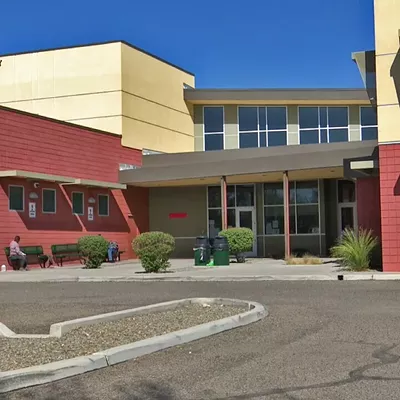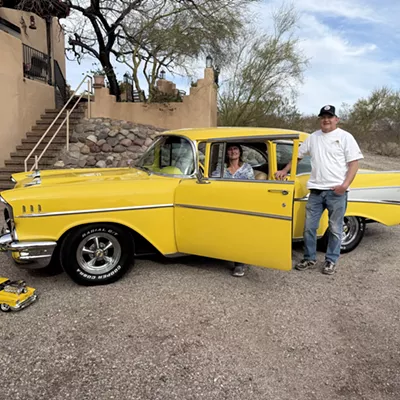What do the Squid, the puke ray and the Transborder Immigrant Tool have in common?
The first two were created with taxpayer money to help secure our borders against those who cross illegally. The Transborder Tool was created with taxpayer money to help people cross our borders illegally.
Is your head spinning yet? Let's see how weird this can get.
The Transborder Tool had its media rollout late last year, and everyone wanted to hear about these Motorola cell phones, equipped with a GPS application, which will be handed out free at migrant centers and other selected sites on the Mexican border.
The holder can press a button to see a compass and directions to the nearest water site, road or church group willing to wrap sore feet. Or, if you're in trouble, the tool will direct you to the nearest Border Patrol rescue beacon.
San Diego State University associate visual arts professor Ricardo Dominguez, one of the creators, says he expects to roll the phones out by midsummer, initially for use on the notorious Devil's Highway on the U.S.-Mexico border.
But Dominguez, a practitioner of what he calls electronic civil disobedience, says the phones eventually will be available for use across Arizona. However, he denies they're intended to help people illegally enter the country.
"At its core, it offers sustenance and safety," says Dominguez, who says his phones will carry recordings of comforting poems in the tradition of Statue of Liberty poet Emma Lazarus. "We want to give the individual at least a few added percentage points on the ability to survive in the desert environment."
Some of the aforementioned publicity raised a pesky question: Is it appropriate for Dominguez and his two co-creators, also faculty members at taxpayer-supported UCSD, to use public money on a product that could aid and abet illegal entry?
"It meets the edges of legal or illegal, and no one exactly knows," says Dominguez. "That 'almost' is the site of the discursive disturbance. Electronic civil disobedience is about opening that discourse of the 'almost.'"
Border Patrol knows a smokescreen when it sees one. "This isn't anything new to us," says Julius Alatorre, a spokesman for the agency's San Diego sector. "Smugglers already use GPS technology, so I don't see this changing anything."
If comparisons to Emma Lazarus and the Statue of Liberty make you nauseous, the Light Emitting Diode Incapacitator might do the same.
This is basically a high-powered flashlight that sends out multicolored light beams at different wavelengths.
"It's like when a flash bulb goes off in your face and makes you see a blue dot afterward," says Bob Lieberman, president of Intelligent Optical Systems, Inc., the California company that invented it. "Just as your eyes get used to having been flashed, it flashes again, and again, and again."
Within 21 feet, the Incapacitator is highly effective at disorienting suspects long enough for lawmen to pounce. Because of the mild nausea it can cause, bloggers have dubbed it the puke ray, although it can also bring on disorientation, vertigo and severe headaches.
Primary funding came from the Borders and Maritime Security Division, an agency within the Department of Homeland Security's Science and Technology Directorate, which has just accepted delivery of 20 prototypes.
Last May, The Wall Street Journal reported the agency has a $40 million budget to spend on all kinds of security gizmos. For example, to thin the amount of Carrizo cane growing along the Rio Grande, which provides cover for smugglers, the agency is testing a plan to introduce Spanish wasps to eat it all up.
If that isn't weird enough, consider the Squid—the Safe Quick Undercarriage Immobilization Device—a product of Engineering Science Analysis Corp. of Tempe.
Picture an ammo box sitting at the side of a road. As a getaway car approaches, the lid flies open, and the box ejects the squid, which unfurls and stretches across the road like a spike strip.
When the getaway car passes, the strip fires tendrils into the vehicle's undercarriage, and these sticky arms wrap around the axles to bring it to a stop. The company has several squid designs—the Sea Squid entangles boats—that operate on the same principle.
They represent a revolution in nonlethal stopping technology, says inventor and company president Martin Martinez, a graduate of Sunnyside High School and the UA.
"We're not just mad scientists," says Martinez, a huge Marvel comics fan who sketched his first Squid design on a napkin. "We're mad scientists crossed with a monster garage."
DHS awarded Martinez's company $750,000 for the Squid prototype.
Let's put away the question of who's burning through more of your money. No one can top our government for that.
But the Transborder Immigrant Tool, even free, is a bad bargain if it puts crossers in greater danger—by making them feel secure enough to make the terrible decision to cross our deserts or forests, or if it keeps them exposed to the elements longer.
For 10 years, Keith Graves was district ranger for the U.S. Forest Service in Nogales and saw the problem firsthand. He supports giving water to illegal aliens to help them get back home, but not to advance deeper into the U.S. illegally.
"If this cell phone provided access to assistance, access to a fire department, a police department, I'd say, 'Good idea,'" says Graves, now a liaison between the Forest Service and the DHS Secure Border Initiative. "But it promotes movement, and the longer you keep people in the desert, the more risk you create for them, by exposing them to bandits, to the elements, to the phone's battery going dead."
If the creative minds at UCSD really want to save lives—without helping people enter the U.S. illegally—Graves suggests placing cell phones at water sites along smuggling routes. As long as the phone receives a signal—and Graves says signals are available at most places where aid is placed—the caller can reach 911.
Many illegal immigrants follow trails that have been used for centuries by traders, Prohibition-era whiskey runners and Apache renegades. After Geronimo's capture and shipment to Florida in 1886, he complained in interviews of something entirely new for him: He kept getting lost in the flat land of his new home.
That never happened in Arizona, because the mountain peaks guided him. And for a while, many of the water bottles found in the tremendous alien garbage dumps in the Altar Valley bore labels, created by some ingenious cross-border entrepreneur, depicting the outline of the Baboquivari Mountains.
Get lost, and you can find a compass point by holding the water bottle up and matching the label to the peaks.
So why isn't the label-maker guy working for DHS?








